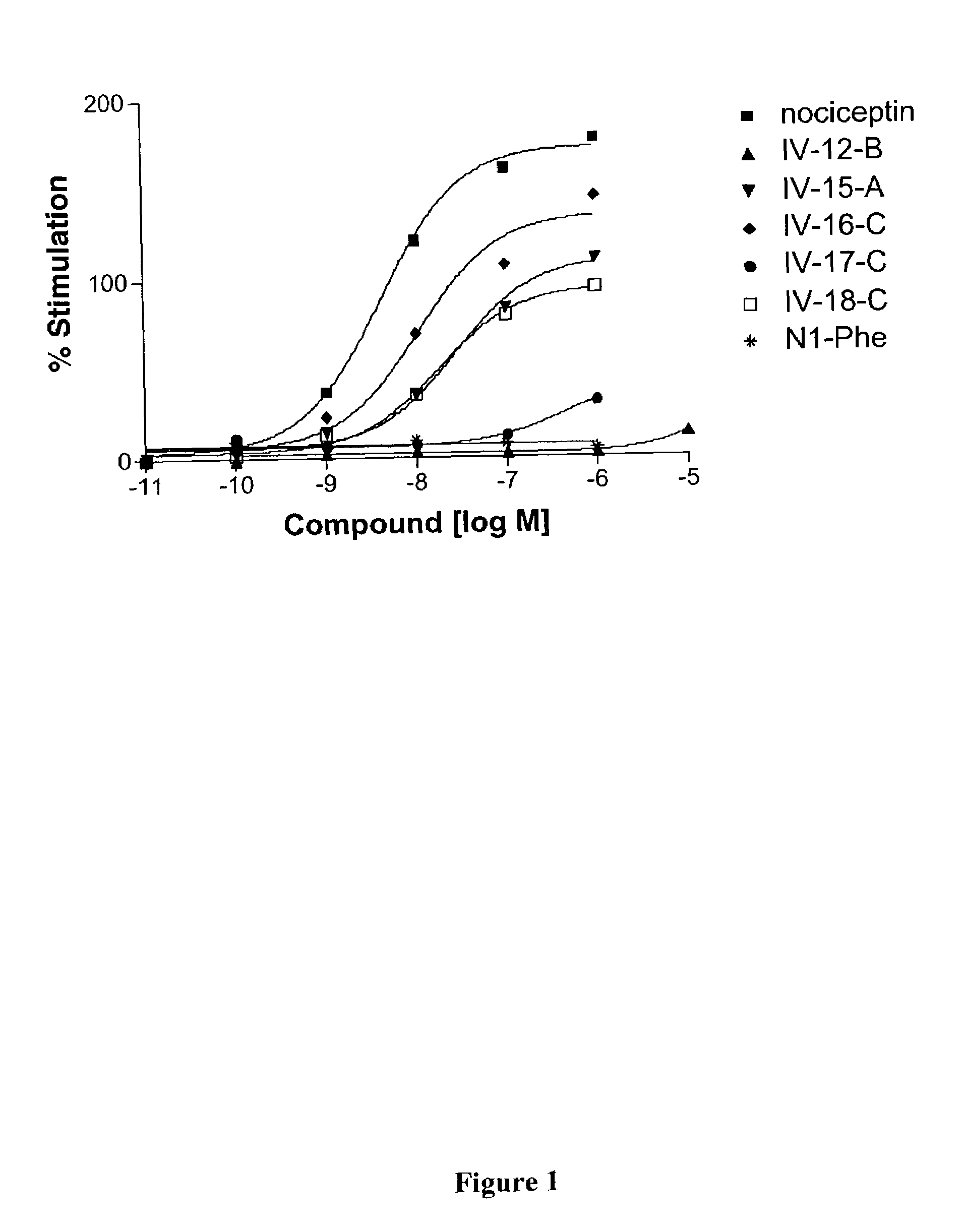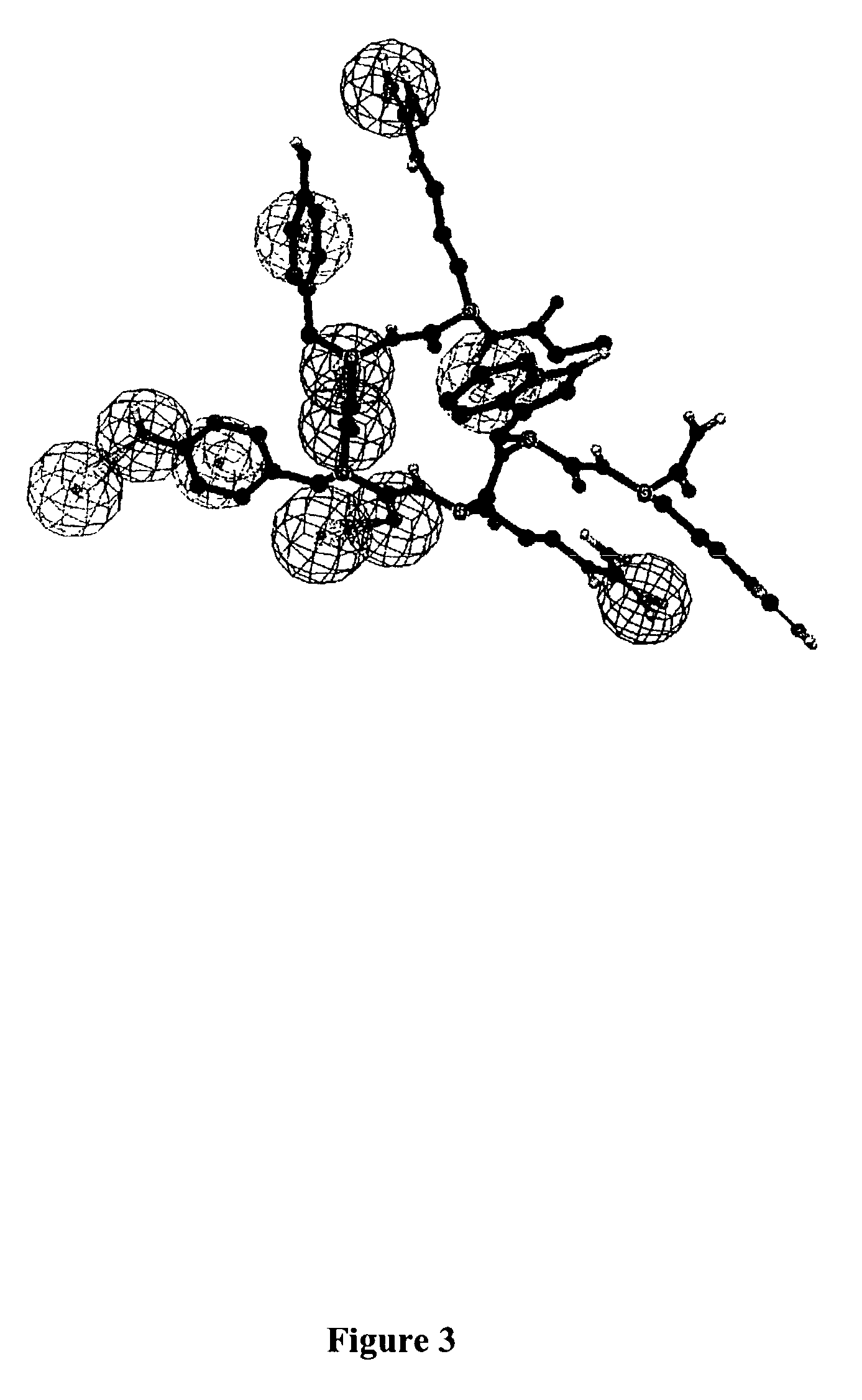Nociceptin-based analgesics
a technology of analgesics and nociceptins, applied in the field of analgesic compounds, can solve the problems of limiting the ability to tolerate the medication for long periods of time, affecting the effect of pain relief, and affecting the ability of patients to tolerate the medication
- Summary
- Abstract
- Description
- Claims
- Application Information
AI Technical Summary
Benefits of technology
Problems solved by technology
Method used
Image
Examples
example 1
[0097]In a first Example, the antagonist VII-7-B (SEQ ID NO: 26) having the sequence: Pentanoyl-RYYRWR-NH2 was assayed for analgesic effects. In this assay, the responses of a control mouse were compared against mice receiving three different dosages of the VII-7-B antagonist (SEQ ID NO: 26). The responses were measured at 5, 10, and 20 minutes after the intracerebroventricular injection of antagonist. The test and baseline latencies were then used to calculate the antinociception as detailed above. In the figure, an asterisk represents a significant difference of a test animal from the respective controls. Here, the antagonist VII-7-B (SEQ ID NO: 26) showed analgesic properties in those mice receiving the 10.0 and 30.0 nmol intracerebroventricular injections at 10 and 20 minutes post-injection.
example 2
[0098]The antagonist was next assayed for the ability to reverse the inhibition of morphine-induced analgesia. In this assay, the control received morphine alone, while test animals received morphine+3 nmol of the antagonist, morphine+10 nmol of the antagonist. These results were compared with test animals receiving morphine+3 nmol nociceptin, morphine+nociceptin+3 nmol antagonist, and morphine+nociceptin+10 nmol antagonist. For each of these animals, response was measured at 5, 10, and 20 minutes after intracerebroventricular injection.
[0099]As shown in FIG. 11, the antagonist did not appear to significantly reverse the inhibition of morphine-induced analgesia. Little reversal was observed in the two animals receiving morphine and antagonist. Some reversal appears to be present in the animals receiving morphine, antagonist, and nociceptin. This result was explored further.
[0100]Referring now to FIG. 12, at 5 minutes post-injection, the administration of 10 nmol of the VII-7-B (SEQ ...
example 3
[0101]The agonist 87-B was next assayed for analgesic effects. In this assay, the responses of a control mouse were compared against mice receiving three different dosages of the VII-87-B agonist (SEQ ID NO: 23). The responses were measured at 5, 10, and 20 minutes after the intracerebroventricular injection of agonist. The test and baseline latencies were then used to calculate the antinociception as detailed above. The results of this assay are shown in FIG. 15. In the figure, an asterisk represents a significant difference of a test animal from the respective controls.
[0102]Here, the agonist VII-87-B (SEQ ID NO: 23) induced pro-nociception in mice receiving 10 nmol of agonist by intracerebroventricular injection at 5, 10, and 20 minutes post-injection.
[0103]The agonist VII-87-B was further investigated by evaluating its ability to reverse morphine-induced analgesia. In this assay, the control animal received 10 nmols of morphine alone, while test animals received morphine+0.1 nmo...
PUM
| Property | Measurement | Unit |
|---|---|---|
| total volume | aaaaa | aaaaa |
| total volume | aaaaa | aaaaa |
| time | aaaaa | aaaaa |
Abstract
Description
Claims
Application Information
 Login to View More
Login to View More - R&D
- Intellectual Property
- Life Sciences
- Materials
- Tech Scout
- Unparalleled Data Quality
- Higher Quality Content
- 60% Fewer Hallucinations
Browse by: Latest US Patents, China's latest patents, Technical Efficacy Thesaurus, Application Domain, Technology Topic, Popular Technical Reports.
© 2025 PatSnap. All rights reserved.Legal|Privacy policy|Modern Slavery Act Transparency Statement|Sitemap|About US| Contact US: help@patsnap.com



